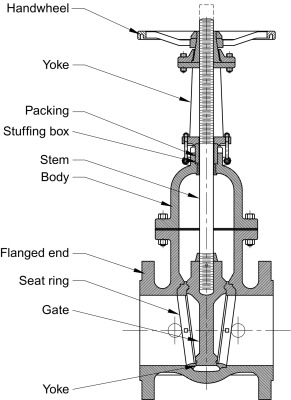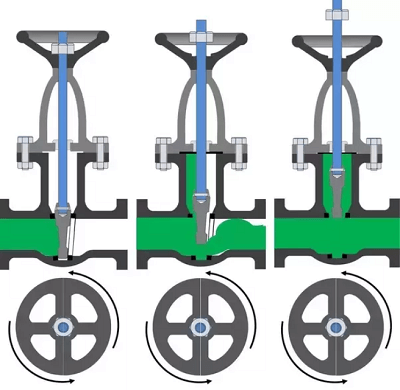With so many industrial valves in the market, how can you know that a particular valve is right for your application? One way to do so is to understand the nitty-gritty about the specific industrial valve.
This article introduces what a gate valve is, what’s its working mechanism and the specific parts that make this industrial valve unique. At the end of this article, you can find out whether gate valves are suitable for your applications.
What Is a Gate Valve?
The gate valve is a member of the linear industrial valve family designed to stop or allow media flow. This valve is bi-directional with a wedge-like disc that can cut through media with thicker particles such as the slurry. The shutoff action is provided by moving the wedge upwards to open or downwards to close the valve.
As most shut-off valves, the gate valve is not recommended to use for throttling although it has the capacity to do so, albeit limited. Its wedge gate is highly prone to damage caused by the vibration of the moving media.
Parts of a Gate Valve
Source: https://www.sciencedirect.com
The typical gate valve has a lot of parts which can be into seven common parts.
-
Body
The body encases the internal parts of the gate valve. This is also the one that gets attached to the pipe system. Gate valve manufacturers use this material for the body to classify these valves. End flanges can be forged, cast or welded.
-
Stem
The stem is what connects the handwheel or actuator to the wedge disc. This directs the proper position of the disc when moving up or down. The stem can be classified as the rising stem or non-rising stem.
In the rising stem design, as you open the valve, the stem moves above the handwheel. For the non-rising stem, the stem is stationary because it is threaded to the disc. As you rotate to open or close the valve, the disc travels on the threads. It is possible that to a fully opened gate valve, the end part of the stem can be exposed to the flowing media.
-
Packing
Packing acts as the gasket which additionally seals the area between the stem and the body. Made of elastomeric material, this is inserted in the stuffing box. If the gland compresses it, a tight seal happens.
-
Bonnet
The bonnet is located on top of the body. This is where the stem passes through, thereby guiding it, as it connects to the disc. There are three kinds of gate valve bonnets.
The screw-in type uses pressure for sealing. The union bonnet makes it easier for plant technicians to clean or maintain the valve. The bolted bonnet is more suitable for high-pressure applications. The pressure seal bonnets are for extreme pressure applications exceeding 2250psi.
-
Gate
The gate or the wedge is the disc that hinders or allows the flow of media through the valve. There are three kinds of wedge discs.
The solid wedge is a solid piece of metal that can be used in almost shutoff applications. The flexible wedge is also a one-disc type but with perimeter cuts that adjust to angles of the seats at the sides.
The split wedge is made of two pieces of solid construction sandwiched between two tapered seats. This is particularly suitable for corrosive liquids moving at normal temperatures.
-
Seat
Seats provide proper seating for the gate disc. Often, these are made of elastomeric materials. The gate valve has two seats, located on each side. These can be integrally constructed with the valve body or in the form of seat rings, which can be threaded or pressed into position, or seal welded to the body.
-
Actuator
Often, you’d find gate valves with handwheels. When operating torque is high, the handwheel is replaced by gears or some kind of actuator. These are fixed with a nut. This signals the opening or closing of the valve. Often you’d find markings that indicate which direction to open or close.
How Does a Gate Valve Work?
Source: https://www.quora.com
The working mechanism for the gate valve is quite simple. While the gate valve may have a number of classifications and designs, how it works remains the same across all designs.
To close the valve, you should rotate the handwheel clockwise. This will move the gate and the stem downwards towards the seat at the lower bottom of the valve. This is the complete closure of the gate valve. The media is blocked in the upstream inlet so no leakage happens. No excessive pressure should be applied when closing the valve to prevent the stem from breaking
To open the valve, you should rotate the valve in counter-clockwise order. Do this without applying too much pressure because it can damage the disc and stem, and leak. If there is pressure, stop turning.
What you should do when there is pressure while turning the valve is to loosen up the packing nut that is located on top of the gate valve body. Loosen it one turn but make sure that this should be tightened after the gate valve is fully open.
The stem and the disc move upwards to allow the passage of the media. A fully opened gate valve does not offer resistance so there is a very minimal pressure drop.
For throttling, you can use the gate valve in a semi-open position. Take note, though, the pressure of the media can damage the disc. There is a great chance of a backflow because of the semi-opened position. It is the backflow of the media that causes more friction, hence the damage. Additionally, operations that use a partially open gate valve dislodges the disc from its position, reducing its efficiency and precision.
What is a Gate Valve Used for?
# Food Services
# Pharmaceutical Services
# Feedwater Applications
# Hydrocarbon Applications
# Steam Applications
# Slurry Application
# Powder Product Application
#Petrochemical and Refinery
Conclusion
Gate valves have one of the simplest working mechanisms. Nevertheless, the gate valve is also one of the most versatile valves to use for industrial applications. Gate manufacturers in India and China can provide high-quality gate valve. If you’d like to know more about gate valves, email XHVAL. Or you can also get the great manufacturers in this complete valve manufacturers guide in China.



